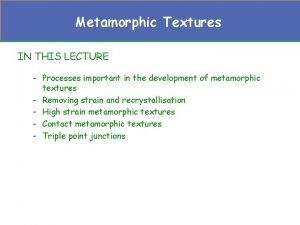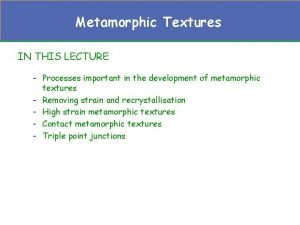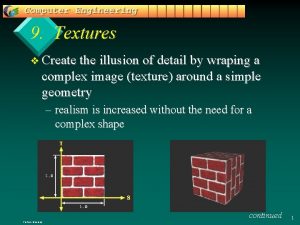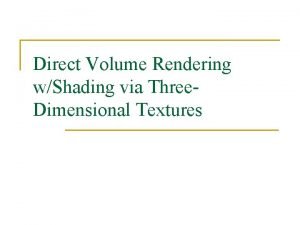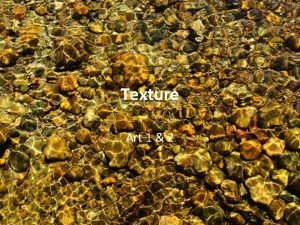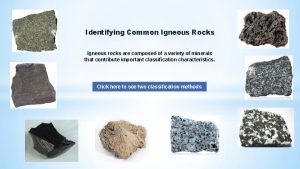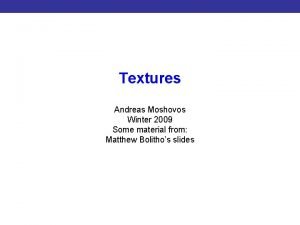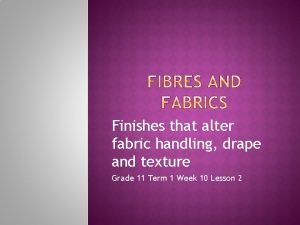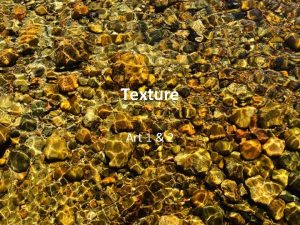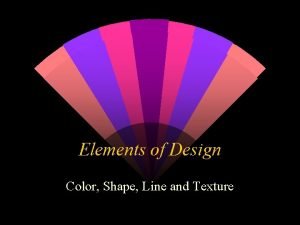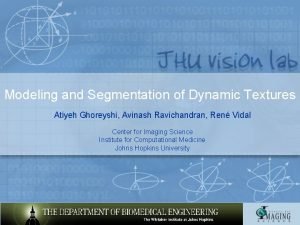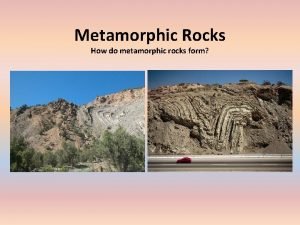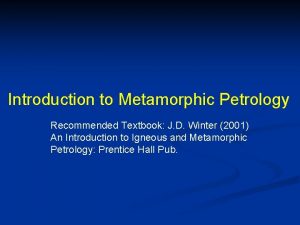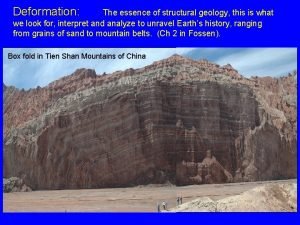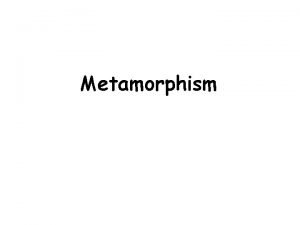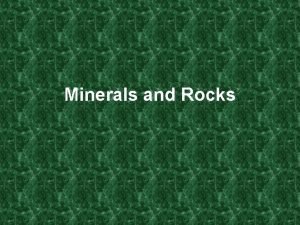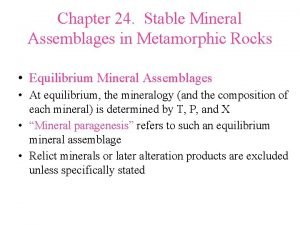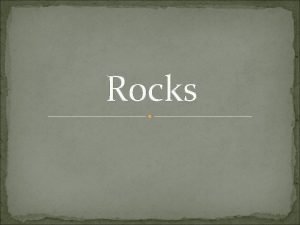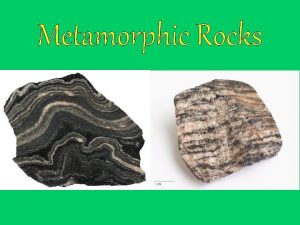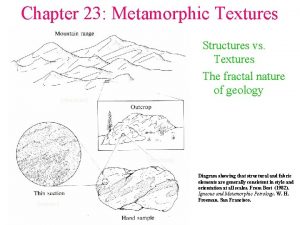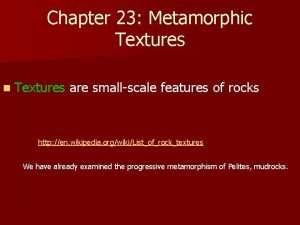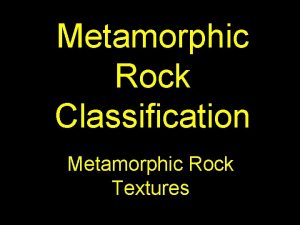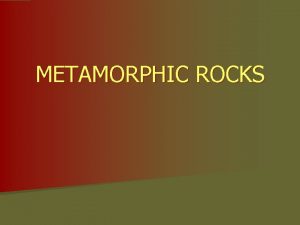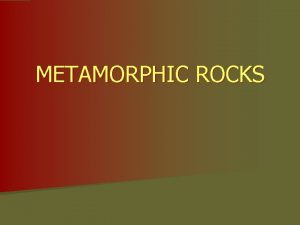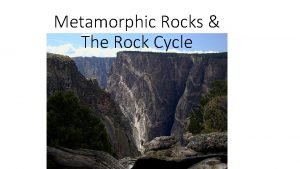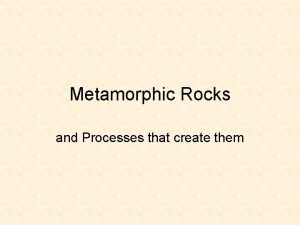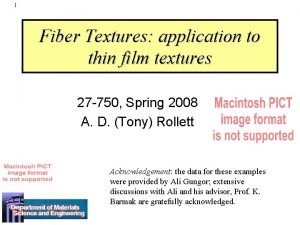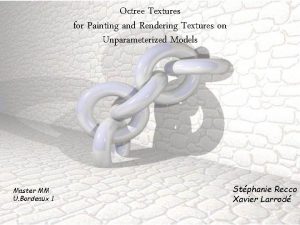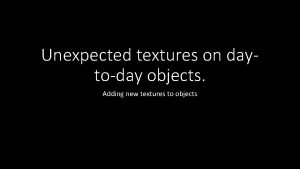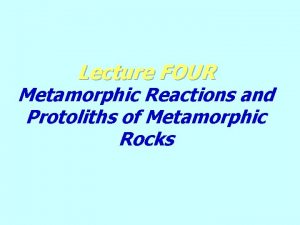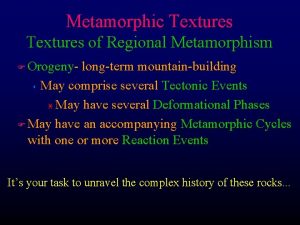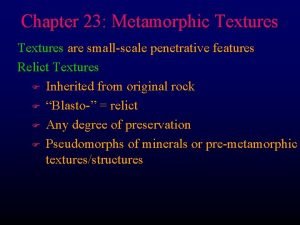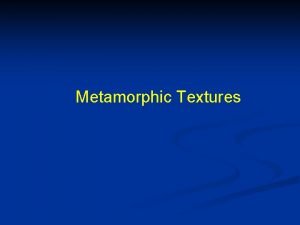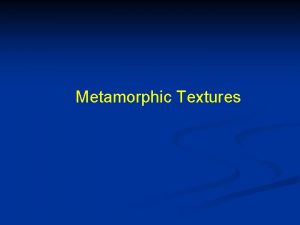Metamorphic Textures IN THIS LECTURE Processes important in































- Slides: 31

Metamorphic Textures IN THIS LECTURE - Processes important in the development of metamorphic textures - Removing strain and recrystallisation - High strain metamorphic textures - Contact metamorphic textures - Triple point junctions

Metamorphic Textures • Textures are small-scale penetrative features • Relict Textures - Inherited from original rock “Blasto-” = relict Any degree of preservation Pseudomorphs of minerals or pre-metamorphic textures/structures

Metamorphic Textures • The processes of deformation, recovery, and recrystallization are central to the development of metamorphic textures 1. Cataclastic Flow - Mechanical fragmentation and sliding, rotation of fragments Crush, break, bend, grind, kink, deformation twins, undulose extinction, shredding of micas, augen, mortar, etc. Technically not metamorphic 2. Pressure Solution

Metamorphic Textures 1. Pressure Solution a. Highest strain in areas near grain contacts (hatch pattern). b. High-strain areas dissolve and material precipitates in adjacent low-strain areas (shaded). The process is accompanied by vertical shortening. c. Pressure solution of a quartz crystal in a deformed quartzite. Pressure solution results in a serrated solution surface in high-strain areas (small arrows) and precipitation in low-strain areas (large arrow). ~ 0. 5 mm across. The faint line within the grain is a hematite stain along the original clast surface. After Hibbard (1995) Petrography to Petrogenesis. Prentice Hall.

Metamorphic Textures 1. 3. Plastic Intracrystalline Deformation - No loss of cohesion - Several processes may operate simultaneously o o Defect migration Slip planes Dislocation glide Deformation twinning

Metamorphic Textures 1. 4. Recovery - Loss of stored strain energy by vacancy migration, dislocation migration and annihilation - Polygonization- general term formation of low-strain subgrains

Metamorphic Textures 1. 5. Recrystallization - Grain boundary migration Subgrain rotation Solid-state diffusion creep at higher T Crystalplastic deformation (general term) o Grain boundary sliding and area reduction Coalescence- recovery and recrystallization by which large grains form by the addition of smaller strained grains by grain boundary migration

Metamorphic Textures Formation of two strain-free subgrains via dislocation migration

Metamorphic Textures a b (a) Undulose extinction and (b) elongate subgrains in quartz due to dislocation formation and migration

Recrystallization by grain boundary migration and sub-grain rotation From Passchier and Trouw (1996) Microtectonics. Springer-Verlag. Berlin. Recrystallized quartz with irregular (sutured) boundaries, formed by grain boundary migration. Width 0. 2 mm. From Borradaile et al. (1982).

High-Strain Metamorphic Textures (shear zones) Schematic cross section through a shear zone, showing the vertical distribution of fault-related rock types, ranging from non-cohesive gouge and breccia near the surface through progressively more cohesive and foliated rocks. Note that the width of the shear zone increases with depth as the shear is distributed over a larger area and becomes more ductile. Circles on the right represent microscopic views or textures. From Passchier and Trouw (1996) Microtectonics. Springer-Verlag. Berlin.

High-Strain Metamorphic Textures • Concentrate on cataclastic > ductile (shallower) • Break, crack, bend, crush, rotate • Slip and shredding of phyllosilicates • Clasts- broken remnants • Porphyroclast- larger remnant in finer crush matrix • Mortar texture • Ribbons • Pseudotachylite

a b Progressive mylonitization of a granite. From Shelton (1966). Geology Illustrated. Photos courtesy © John Shelton.

c d Progressive mylonitization of a granite. From Shelton (1966). Geology Illustrated. Photos courtesy © John Shelton.

High-Strain Metamorphic Textures

Figure 22 -3. Terminology for high-strain shear-zone related rocks proposed by Wise et al. (1984) Fault-related rocks: Suggestions for terminology. Geology, 12, 391 -394.

Contact Metamorphic Textures l l Typically shallow pluton aureoles (low-P) Crystallization/recrystallization is near-static - Monomineralic with low D surface energy ® granoblastic polygonal - Larger D S. E. ® decussate l l Isotropic textures (hornfels, granofels) Relict textures are common

Progressive thermal metamorphism of a diabase (coarse basalt). From Best (1982). Igneous and Metamorphic Petrology. W. H. Freeman. San Francisco.

Progressive thermal metamorphism of a diabase (coarse basalt). From Best (1982). Igneous and Metamorphic Petrology. W. H. Freeman. San Francisco.

Progressive thermal metamorphism of a diabase (coarse basalt). From Best (1982). Igneous and Metamorphic Petrology. W. H. Freeman. San Francisco.

Progressive thermal metamorphism of a diabase (coarse basalt). From Best (1982). Igneous and Metamorphic Petrology. W. H. Freeman. San Francisco.

Progressive thermal metamorphism of slate. From Best (1982). Igneous and Metamorphic Petrology. W. H. Freeman. San Francisco.

Progressive thermal metamorphism of slate. From Best (1982). Igneous and Metamorphic Petrology. W. H. Freeman. San Francisco.

Progressive thermal metamorphism of slate. From Best (1982). Igneous and Metamorphic Petrology. W. H. Freeman. San Francisco.

The Crystalloblastic Series Most Euhedral Titanite, rutile, pyrite, spinel Garnet, sillimanite, staurolite, tourmaline Epidote, magnetite, ilmenite Andalusite, pyroxene, amphibole Mica, chlorite, dolomite, kyanite Calcite, vesuvianite, scapolite Differences in development of crystal form among some metamorphic minerals. From Best (1982). Igneous and Metamorphic Petrology. W. H. Freeman. San Francisco. Feldspar, quartz, cordierite Least Euhedral

Contact Metamorphic Textures Typical textures of contact metamorphism. From Spry (1969) Metamorphic Textures. Pergamon. Oxford.

Grain boundary energy controls on triple point angles c. a. Dihedral angle between two mineral types. When the A-A grain boundary energy is greater than for A-B, the angle will decrease (b) so as to increase the relative area of A-B boundaries. Winter (2001) An Introduction to Igneous and Metamorphic Petrology. Prentice Hall. c. Sketch of a plagioclase (light)-clinopyroxene (dark) hornfels showing lower dihedral angles in clinopyroxene at most cpx-plag boundaries. (c. from Vernon, 1976) Metamorphic Processes: Reactions and Microstructure Development. Allen & Unwin, London.

Grain boundary energy controls on triple point angles a Drawings of quartz-mica schists. a. Closer spacing of micas in the lower half causes quartz grains to passively elongate in order for quartz-quartz boundaries to meet mica (001) faces at 90 o. From Shelley (1993). b. Layered rock in which the growth of quartz has been retarded by grain boundary “pinning” by finer micas in the upper layer. From Vernon, 1976) Metamorphic Processes: Reactions and Microstructure Development. Allen & Unwin, London. b

Metamorphic Textures • Contact overprint on earlier regional events are common - Thermal maximum later than deformational - Separate post-orogenic (collapse) event • Nodular overprints • Spotted slates and phyllites

a b Overprint of contact metamorphism on regional. a. Nodular texture of cordierite porphyroblasts developed during a thermal overprinting of previous regional metamorphism (note the foliation in the opaques). Approx. 1. 5 x 2 mm. From Bard (1986) Microtextures of Igneous and Metamorphic Rocks. Reidel. Dordrecht. b. Spotted phyllite in which small porphyroblasts of cordierite develop in a preexisting phyllite. Winter (2001) An Introduction to Igneous and Metamorphic Petrology. Prentice Hall.

Depletion haloes Progressive development of a depletion halo about a growing porphyroblast. From Best (1982). Igneous and Metamorphic Petrology. W. H. Freeman. San Francisco. Figure 23 -13. Light colored depletion haloes around cm-sized garnets in amphibolite. Fe and Mg were less plentiful, so that hornblende was consumed to a greater extent than was plagioclase as the garnets grew, leaving hornblende-depleted zones. Sample courtesy of Peter Misch. Winter (2001) An Introduction to Depletion halo around Igneous garnetand porphyroblast. Boehls. Prentice Butte Hall. area, Idaho Metamorphic Petrology.
 Grain rotation
Grain rotation Metamorphic textures
Metamorphic textures Concurrent in os
Concurrent in os 01:640:244 lecture notes - lecture 15: plat, idah, farad
01:640:244 lecture notes - lecture 15: plat, idah, farad The illusion of detail
The illusion of detail Partially resident textures
Partially resident textures Rendering fur with three dimensional textures
Rendering fur with three dimensional textures Invented texture.
Invented texture. Rock textures chart
Rock textures chart Cuda texture object
Cuda texture object Textures drape fabric
Textures drape fabric Texture actual
Texture actual A surface that reflects a soft dull light
A surface that reflects a soft dull light Which line creates a feeling of height and formality?
Which line creates a feeling of height and formality? Dynamic textures
Dynamic textures Least important to most important
Least important to most important Newspaper article format
Newspaper article format Inverted pyramid in news writing
Inverted pyramid in news writing Dr ziad salem
Dr ziad salem Regional metamorphism rock
Regional metamorphism rock Oxygen level in air
Oxygen level in air Metamorphism
Metamorphism Metamorphic facies
Metamorphic facies Metamorphic rock
Metamorphic rock How are metamorphic rocks classified
How are metamorphic rocks classified Regional metamorphism rock
Regional metamorphism rock Luster streak
Luster streak Biotite
Biotite Importance of metamorphic rocks to man
Importance of metamorphic rocks to man Types of igneous rock
Types of igneous rock Sedimentary and metamorphic rocks section 6.1
Sedimentary and metamorphic rocks section 6.1 Foliated metamorphic rocks
Foliated metamorphic rocks
